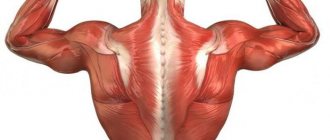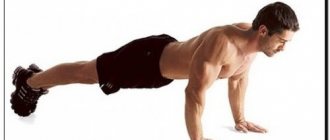Shuttle running is speed running over short distances. The difference from the usual one is that the distance according to the rules must be covered several times. This type of running allows you to improve your acceleration and quick start techniques.
In addition, shuttle running is sometimes used to determine speed characteristics when it is not possible to run 100 meters. As a rule, shuttle running is practiced in gyms; any distance can be chosen for this - from 10 to 100 meters. This is the best training for improving an athlete's speed abilities.
What is shuttle running
Shuttle running, being undoubtedly a type of cross-country athletics, was not included in the program of athletics competitions, but gained prestige in schools in physical education classes, in the “Ready for Labor and Defense” (RLD) complex and became a mandatory physical fitness test for employees law enforcement agencies.
50 developmental exercises for training at home
Shuttle running is running over a short distance with a constant change of direction between two points. Simply put, running back and forth. The runner starts to the designated point, runs around it or touches the line and returns to the start along the same route, repeating the combination up to 10 times. Everything is very simple, but at the same time it is not at all easy for your body.
How to prepare for passing FISO standards: main rules
Study space
Shuttle running classes are held in stadiums, specially surfaced areas, and gyms.
Safety requirements:
- The area is flat with a hard surface that provides adhesion to the shoes. Do not exercise on wet or slippery surfaces.
- The start and turn lines are located away from walls and fences. There is a danger of flying into an obstacle at speed and getting injured. The lines are drawn parallel to each other at a distance of 10 meters , their width is included in this segment.
- Choose sneakers for classes. For shoes, the main thing is grip. You should pay attention to the combination of materials. The leather will retain the shape of the sneakers, and the fabric will allow the foot to breathe. The cushioning of the sole is selected taking into account the characteristics of the foot, since manufacturers place spring elements on the heel and toe of the sneaker or a combination of both elements.
- Clothing does not restrict movement and does not dangle. These are leggings, tops, special T-shirts.
Suitable compression clothing that;
- Maintains the temperature of heated muscles, but allows the body to breathe.
- Does not restrict movement.
- Plus, it removes excess liquid.
- The downside is the high cost.
Types and distances of shuttle running
Types of shuttle running can be completely different both in execution technique, the distance between the points run, and the number of repetitions. In general, three types will be the most popular:
- 3x10 – this distance is for elementary school students and it is also included as a standard in the GTO complex. The test taker is required to run a distance of 10 meters back and forth three times.
- 4x9 - this type of shuttle running is used in physical education lessons in high school.
- 10x10 - This distance and number of repetitions is used as a test of physical fitness in the power structures. This is where the real test of dexterity and coordination lies!
In addition to the above-mentioned types, there are also those when a person runs in one direction facing forward and returns with his back. The length of one line is often 10 meters, but can reach up to 100 m. In some shuttle races you need to run around the end point, and in others you need to turn around, touching it with your hand, etc.
source: michaelhoeweler.tumblr.com
As you can see, the variations of what the shuttle run will be like depend on your imagination. That’s why shuttle running is more of a type of general physical training (GPP) than athletics, so it would be logical to continue our article with an answer to the question: what qualities does such running develop?
Features of shuttle running
Naturally, training requires a special shuttle running technique at each stage:
- start;
- running along a distance with acceleration;
- preparation for the turn and the turn itself;
- finish line.
The continuation of the distance is carried out in one algorithm, only a jerk is added at the finish line.
In principle, for those who use shuttle running in training, its execution technique is the same for distances of different lengths and does not depend on the number of repetitions. The only peculiarity: depending on the length of the run and how many times it will be completed, you need to learn how to choose the optimal pace of movement. The rule is the same as in track and field running:
- short distances must be immediately performed with great intensity and using all power potential;
- long distances with a large number of repetitions in the first half should be performed at an average pace, saving energy, and after passing the equator, increase the speed and give your best in the last segment of the distance.
These rules are relevant for professional athletes who are going for a record, or when they need to pass the standard. When training for general development, shuttle running can be performed at any convenient pace.
What qualities does shuttle running train?
When performing a shuttle run, you develop high speed to run a short distance to the end point, but almost immediately you need to turn around to run back, and so on a certain number of times. This is where the sense of balance is activated to the maximum, a large number of muscles are involved, coordination and your speed qualities develop.
As general physical training, shuttle running is a mandatory training program for football players, tennis players, hockey players and other athletes, where running is present, but along an inconsistent trajectory.
To diversify your running workouts, you can also include shuttle running. It will help you develop resistance to changes in pace, develop general motor skills of the body, speed-strength qualities, and explosive power of the leg muscles.
And if you are preparing for a start where there are sharp turns or even 180-degree turns, you will get the maximum benefit from shuttle running, since you will be ready to quickly change direction without losing speed.
Physical Fitness for Runners: 30 Bodyweight Exercises
Common mistakes
Many beginners cannot get the maximum benefit from running because they encounter the following mistakes:
- They don't warm up properly. This exercise involves the work of simply a huge number of joints, muscles and ligaments.
- Incorrect distribution of the entire load. To avoid a lack of endurance after half the distance, you should start jogging at an average pace and gradually increase it, using the explosive power of the muscles of the limbs.
- Very slow stop before turning around. For a correct turn, there is no need to reduce the intensity, it must be done sharply, this way the speed will be the same and the inertia will be maintained.
- Overloading. When performing such high-intensity cardio exercises, it is important to monitor your training volume, as this can have serious negative consequences.
It has been proven that this running helps professional athletes improve their performance and skills, and also improves the physical fitness of amateurs. In addition, it gives a charge of vivacity and a great mood.
Shuttle running technique and basic mistakes
Shuttle running is performed on a flat surface with a hard surface. Your shoes should not be slippery. Before you start exercising, warm up well: under no circumstances should you start this traumatic type of running with unwarmed muscles!
The execution technique will depend on the distance: for the short one you should use your full speed potential, and for the long one (10x10 or races with segments of 100 meters), perform the first half at medium intensity, accelerating towards the final segments.
Video: technique for performing the 3x10 meter shuttle run from the All-Russian Sports Society "GTO".
The remaining technical aspects are the same:
Start
- Taking the starting position (high start), place your supporting leg forward and move the center of gravity of the body to it. Lean your body forward, but do not bend your back. Focus power in your quads for an explosive start.
Movement along the distance
- On the command “March!” you must reach the end of the segment, touch the line or any other object and return to the starting line. To maintain maximum speed over such short distances, land on your toes rather than your entire foot.
Rotate 180 degrees
- The whole highlight of shuttle running is the turn, which forces the athlete to first slow down and then pick up speed again. To properly perform a turn, you need to apply a stopping step as you approach it to reset the momentum. Turn around like this: turn the foot of your front leg at a right angle in the direction of the turn, turn your body sideways and push off with your forward leg.
Breath
6-Week Training Plan for Your First 10K Race
- It is recommended to breathe in a 2x2 pattern, which means two steps as you inhale and two steps as you exhale.
Features of the technology
There are often cases when it is easier for athletes to run a hundred meters than to perform a 3x10 shuttle run. This is due to the fundamentally different nature of the movements. If in the case of a 100-meter run an athlete always runs in one direction with maximum acceleration, then during a shuttle run he needs to accelerate, brake, most often touching the ground, turn 180 degrees and perform the same procedure a few more times. once. This type of load exhausts the muscles and the body as a whole much faster. Therefore, when shuttle running, it is important to pay great attention to technique , be it performing 3x10 or 10x10 intervals.
Before performing the actual workout, it is important to do a full warm-up, focusing on the knee and ankle joints, injuries to which are most common during shuttle running. The warm-up should include as many rotational movements as possible to prepare the ligaments and joints for the work ahead.
Errors
Main mistakes if you pass the GTO standard:
- false start;
- failure to cross the line during a turn;
- interfering with other test takers.
You will not receive credit for these mistakes.
The following errors can hinder a good final time:
- You have distributed the load incorrectly. On a short distance of 3x10 meters, you should work to your maximum from the very beginning, but when covering 10 segments, try not to become exhausted in the first half.
- Slow braking before turning. A stopping step does not mean a gradual reduction in speed; with a stopping step, you are preparing your leading foot for a sharp turn. In other words, it's like you're stopping while you're turning, but by maintaining momentum, your speed doesn't drop.
- Having become accustomed to turns, athletes often make the unfortunate mistake of braking before the finish line. Remember, when you have passed the last turn and started running for the last stretch, you must go through it as fast as you can, crossing the line.
Basic beginner mistakes
A little later we will look at what is good for the body with shuttle running and whether harm is possible, and now we will analyze the main mistakes that almost all beginners in this sport make:
- Never start learning to run at high speeds right away;
- First of all, learn to control the difference in speed;
- Learn to move correctly when starting and turning;
- Don't forget to warm up before starting your workout. All muscles must be thoroughly warmed up to avoid sprains and injuries.
- Remember the rule with which you will understand how to quickly run the 10x10 shuttle race: the tips boil down to one recommendation - first learn the correct execution technique, and then start increasing your speed results. And nothing else!!!
Shuttle running training program
Are you preparing to pass the GTO standards? Then this block is for you! Below we will provide a table of standards for age categories, but for now we will tell you how to prepare for testing.
It is better to conduct classes at an athletics stadium with a rubber track. This is the coating that will hurt your feet the least. Don’t even consider asphalt, and especially concrete, for training.
In the methodological literature, beginners are encouraged to use the following combinations on different training days:
- 3 sets according to the 4x9 pattern;
- 5 sets 4x9;
- 3 sets of 4x15;
- 5 sets of 4x15;
- 3 sets of 4x20;
- 1 race according to the 10x10 pattern.
To progress, it is also recommended to include work with a jump rope in your classes to strengthen your foot for toe running: jumping will increase the power of the musculoskeletal system, pump up the calf muscles and give you a powerful push-off while running. For jumping exercises, use side jumps. With them you will increase the strength of those muscles that work when gaining speed after a turn.
Practice shuttle running at low speed first, and when your muscles adapt to such work, increase the pace. And, of course, before performing sets, do not forget to do a thorough warm-up, including:
- jogging at an easy pace – 10-15 minutes;
- general developmental and special running exercises – 10-15 minutes;
- acceleration by 50-60 meters with an emphasis on running on the toes - 2-3 repetitions.
SBU complex: 9 special running exercises with video
Who can't?
Before you begin these exercises, you should familiarize yourself with the contraindications. So, you shouldn’t get carried away with shuttle running if you have:
- cardiovascular diseases;
- varicose veins of the lower extremities;
- thrombophlebitis;
- poor blood circulation;
- heart attack;
- stroke;
- any disease in the acute stage.
Shuttle running not only helps athletes improve their skills, but also improves the physical fitness of non-professional amateurs. And in addition, it lifts your spirits and gives you a boost of energy.
Standards for shuttle running
Let's consider the standards for shuttle running at a distance of 3x10 meters, which is taken by children and adults in the GTO.
Men
Table of standards for shuttle running, men
Women
Table of standards for shuttle running, women
For adults aged 30 years and older, shuttle running is not included in the program for passing the GTO standards. This is due to the fact that after 30 years the condition of bone tissue and the elasticity of ligaments and joints gradually deteriorate.
Employees of the Ministry of Internal Affairs and the Ministry of Emergency Situations pass shuttle running standards at distances of 10x10 meters and 4x20 meters, but the scoring grid is too fractional, so we leave for readers a link to the resource: standards of the Ministry of Internal Affairs and the Ministry of Emergency Situations. If an employee does not meet the specified standard, he is sent for recertification.
Rules, distances and standards
Most often, intermediate distances during shuttle running are shuttle running 10x10 meters. The runner must run 10 meters there and back 10 times.
For professional athletes, the range is selected taking into account the athlete’s preparedness and the tasks that must be solved during the training process.
The rules for this type of running cannot be called complicated.:
- on a site without unevenness, 10 meters are measured;
- “Start” and “Finish” are indicated;
- start is made from a high or low position;
- the movement is carried out to the 10 meter mark, which the runner must touch;
- touch is a signal to fulfill the elements of the standard;
- after touching, the sprinter turns around and runs in the opposite direction, touching the line again, he turns around and runs again.
Standards for boys from 6 to 17 years old:
| Age, years | Great, sec | Okay, sec | Satisfactory, sec |
| 6-8 | 9,2 | 10 | 10,3 |
| 9-10 | 8,5 | 9,3 | 9,6 |
| 11-12 | 7,9 | 8,7 | 9 |
| 13-15 | 7,2 | 7,8 | 8,1 |
| 16-17 | 6,9 | 7,6 | 7,9 |
Standards for girls:
| Age, years | Great, sec | Okay, sec | Satisfactory, sec |
| 6-8 | 9,5 | 10,4 | 10,6 |
| 9-10 | 8,7 | 9,5 | 9,9 |
| 11-12 | 8,2 | 8,1 | 9,4 |
| 13-15 | 8 | 9 | 9 |
| 16-17 | 7,9 | 8,9 | 8,9 |
Standards for men:
| Age, years | Great, sec | Okay, sec | Satisfactory, sec |
| 18-24 | 7,1 | 7,7 | 8 |
| 25-29 | 7,4 | 7,9 | 8,2 |
Standards for women:
| Age, years | Great, sec | Okay, sec | Satisfactory, sec |
| 18-24 | 8,2 | 8,8 | 9 |
| 25-29 | 8,7 | 9 | 9,3 |
How to improve your results
The correct technique for performing shuttle running alone may not be enough to effectively cover the distance. Of course, technicality is the main key to covering the distance. But to improve the results and safety of classes, it is important to consider the following recommendations:
- Be sure to warm up. Shuttle running is one of the most traumatic types of timed running. Therefore, before covering the distance, perform a quality warm-up that warms up all muscle groups, ligaments and tendons. Stretch muscles make it faster and easier to get into the pace and go the distance better. If you skip this step, you may suffer damage to your calf muscles.
- Exercise regularly. For example, in order to pass school standards for this type of activity, you need to study regularly for at least a month. During this time, the muscles will tone and adapt to the load.
- Stretching the calf muscles. Thanks to proper stretching, good muscle recovery ability, strength and endurance are maintained. To strengthen your legs, be sure to work on their flexibility.
All this will make shuttle running as useful, effective and safe as possible. We invite you to watch a video describing this technique.










